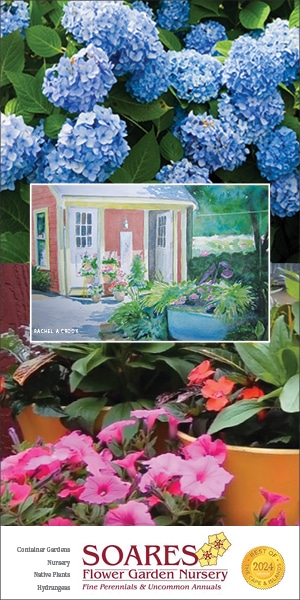
Heritage Museums art exhibit looks at landscapes in a whole new light
Cape Cod Art / Annual Art 2017 / Art & Entertainment, People & Businesses
Writer: Marina Davalos
Heritage Museums art exhibit looks at landscapes in a whole new light

Cape Cod Art / Annual Art 2017 / Art & Entertainment, People & Businesses
Writer: Marina Davalos

“The Beginning of Summer” by Jane Freilicher • Artwork courtesy of Heritage Museums & Gardens
Exhibit presents traditional views alongside cityscapes, urban scenes and abstract works
“Painted Landscapes: Contemporary Views” is an exhibit of landscape paintings that challenges traditional concepts about what a landscape painting is. The exhibit features not only classic American landscape paintings, influenced by the early 19th-century Hudson River School, but also cityscapes as well as urban, industrial and abstract works. Because it focuses on contemporary views about what a landscape is, “this exhibit takes the landscape further,” says Amy Dean, Heritage Museums & Gardens’ marketing director.
The exhibit, which opened at Heritage in April and runs through October 9, 2017, is based on the book Painted Landscapes: Contemporary Views (2013) by Lauren Della Monica, founder of LPDM Fine Art Consulting in New York City. As an art advisor, Della Monica curates works of art for private collections and shows. Over time, she became fascinated by the fact that no matter how diverse her clients’ tastes were, they almost always chose a landscape painting as part of their collection. “For some, those paintings are traditional landscapes, and others gravitate toward urban or abstract landscapes,” says Della Monica. “Even though landscape paintings are everywhere, landscape painting doesn’t get much attention because it is thought of as being a traditional genre. I thought it would make an exciting project to show viewers what I had been seeing across the country.” The result of five years of research, Della Monica’s book features the works of 60 contemporary American artists, including Cape Cod’s Jim Holland.
Ellen Spear, Heritage’s president and CEO, met Della Monica in 2013 at a book signing. “I was flabbergasted by Painted Landscapes,” says Spear. “The approach by contemporary painters and the regional differences in their work spoke to the range of environmental issues around the country.” Spear was so taken by the book that she invited Della Monica to guest-curate an exhibit at Heritage based on it. “We’re an indoor and outdoor museum,” Spear says, “so it’s the perfect venue.” While the book is divided into geographical sections, the exhibit is arranged by five underlying themes that Della Monica contemplated in her research: history and interpretation, place, structure and landscape, the tree, and the act of painting.
History and Interpretation
Painters today build upon traditions and also create their own, Della Monica notes in the introduction she wrote for this section. “Hopper’s House” (2008), by Jim Holland, who lives and works on Cape Cod, is a tribute to early 20th-century painter Edward Hopper. The painting, which appears on the cover of Della Monica’s book, depicts Hopper’s house situated on a green landscape against the sea in Truro; it’s a classic, realistic rendering. Alex Katz’s “Trees Against Blue Sky” (1987), on the other hand, shows simple black silhouettes of trees, bordering on the abstract, against a twilight blue sky; it’s part of a series of Maine skyscape paintings. Lois Dodd’s “Tunnel at Vail in Snow” (1978) highlights the juxtaposition of man-made and natural elements. “Vail is a small town in New Jersey,” says Dodd, who lives in New York City and has been exhibiting her work since the 1950s. “They’d start to build railroads and never finish them, and I became very intrigued with the unfinished railroads and tunnels as far as landscapes.”
Also included in this section of the exhibit is Hopper’s “Blackhead, Monhegan” (circa 1918), an original oil on panel from the Collection of the New Britain Museum of American Art in Connecticut.
Place
Landscapes in this section reflect both specific locations and broader concepts of environment. April Gornik’s “Appalachian Night” (2001) is a larger-than-life realistic painting that pulls the viewer in with its orange-pink clouds behind a silhouette of the Appalachian Mountains. In contrast, “Verdeseeps,” (2009) by Johnnie Winona Ross, features alternating horizontal stripes of white and gray with thin strands of green that seem to emanate from behind. Elizabeth O’Reilly’s “Grist Terminal Reflected” (2011) and “Third Street with Circle” (2011) show semirealistic urban and industrial scenes, also depicting locations where the man-made meets the natural world.

“Current” by Randall Exon • Artwork courtesy of Heritage Museums & Gardens
Structure and Landscape
The artists whose work appears in this section consider structure in terms of exploration of line and space. Paul Resika challenges viewers with “Blue Wave” (2008-09). One can tell this is a Cape Cod lighthouse scene, but it’s pared down to simple shapes—sharp, brightly colored triangles, rectangles and circles. Vertical lines dominate in Sarah McKenzie’s “Scrim” (2011), a close-up of skyscrapers seen through a hotel window. “I’ve always been intrigued by where the landscape meets culture,” says McKenzie, who lives in Boulder, Colorado. “I’m interested in how the built landscape reveals the larger dynamic of our culture.” David Kapp’s “Square Crowd” (2010) shows a bird’s-eye view of New Yorkers crossing a busy intersection. In this painting, done with loose brush strokes that create a sense of motion, the people are the landscape. “I’m concerned with the urban landscape. I like it because it’s confrontational,” says Kapp, who lives in New York City.
The Tree
Painters often use a natural object in their works for form and structure, such as a tree or trees, according to Della Monica. Sylvia Plimack Mangold’s “Summer Maple, 2008” (2008) is a realistic-looking close-up of a maple treetop. In contrast, Wolf Kahn’s “Pond and Pine Trees #2” (1974) shows a grove of trees, highlighted with splashes of purples and magenta. In her book, Della Monica writes that Kahn often uses “nonsensical” colors in his landscapes, and the colors become the subject of the work. Sam Cady’s “Cypress, Pacific Coast” (1996) is more photo-realistic, showing intricate details of the tree against a nonexistent sky—Cady intentionally left the background white so that the focus is on the cypress.
The Act of Painting
In the introduction to this section, Della Monica notes that the landscape is almost secondary to process and style. Yvonne Jacquette’s “Late Sun Above Madison Square Park II” (2012) features a dark, quiet cityscape with square grid patterns for the windows of the skyscrapers, creating a deliberate flat look. Rackstraw Downes’s “New Plantings in Millennium Park After Labor Day Rains of 2002” (2002) puts the focus on the newly planted trees in the park, rather than the park itself or the skyscrapers in the distance.
The book—and Heritage’s exhibit of the work—has encouraged the featured artists, themselves, to speculate upon what constitutes landscape painting today. “With Painted Landscapes, Lauren has shown the breadth of landscape painting,” Jim Holland says. “She has opened people’s eyes to what landscape painting can be.” David Kapp echoes the sentiment. “What is landscape painting today?” Kapp asks. “It is this curatorial exhibit.”
Heritage Museums & Gardens is located at 67 Grove Street, Sandwich. For more information, call 508-888-3300, or visit heritagemuseumsandgardens.org.



